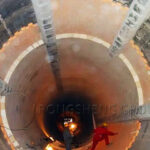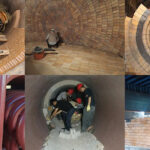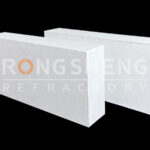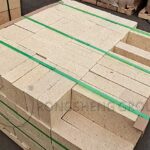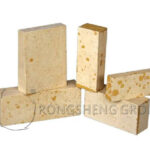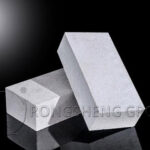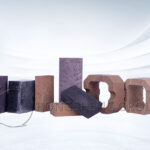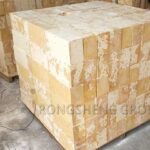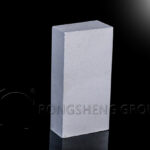Phosphate-bonded high alumina brick is a kind of unfired brick. High alumina bricks are made by semi-dry machine pressing and heat treatment. The raw material is dense super-grade bauxite clinker, and phosphoric acid with a concentration of 42.5%~50% is used as a binder. The heat treatment temperature is 400~600°C. As one of the furnace bricks suppliers, Rongsheng refractories brick manufacturers can provide refractory bricks for sale.
Application of Phosphate Bonded High Alumina Brick in Cement Kiln
In the process of cement kiln masonry, the construction parts have different shapes, and the specifications of the phosphate-bonded high-alumina bricks used are relatively diverse. For example, the standard size is 230*114*65mm, and the phosphate-bonded high-alumina knife-edge brick has a size of 230*114*65/55mm. And phosphate-bonded ax bricks, phosphate-bonded universal arc bricks, etc.
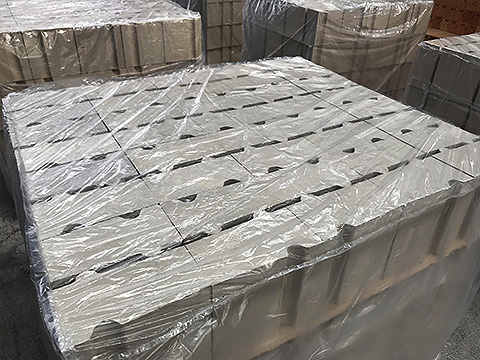
Phosphate-bonded high-alumina bricks are mainly used in the transition zone, firing zone, cooling zone, castor cooler, kiln hood, and a working layer of the shaft kiln of the cement rotary kiln. According to the requirements of use, adding kyanite, sillimanite, pyrophyllite and silica to the ingredients can prevent the volume shrinkage of phosphate bricks during use. Adding fused corundum and mullite in the form of the matrix can improve the load-softening temperature and corrosion resistance. buy fire bricks online, the phosphate bonded high alumina brick of Rongsheng refractory brick manufacturer can be customized according to the shape, size, and parameter specifications provided by customers.
Characteristics of Phosphate High Alumina Brick
- 1) High-temperature resistance.
- 2) High strength at room temperature and high temperature, excellent wear resistance.
- 3) Rapid cooling and heat resistance, excellent thermal shock resistance.
- 4) Good chemical corrosion resistance.
- 5) The disadvantage is that the load softening temperature is low, which limits its application range.
Phosphate refractory bricks are divided into phosphate bricks and phosphate wear-resistant bricks. The difference is that phosphoric acid is used as a binder for phosphate bricks, and aluminum dihydrogen phosphate is used as a binder for phosphate wear-resistant bricks. It is generally divided into low-grade phosphate bricks and high-temperature phosphate bricks. There is little difference between these two bricks because phosphate bricks have better wear resistance. High-grade phosphate bricks are high-load soft phosphate bricks.
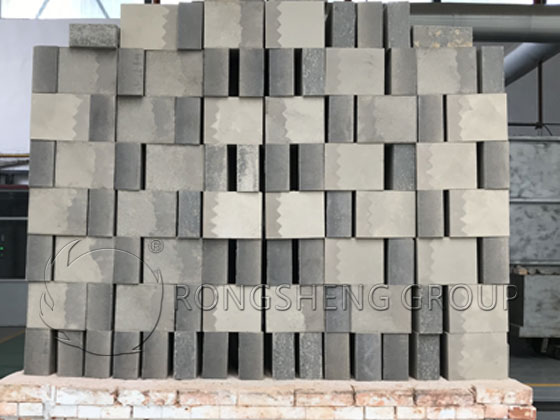
Ordinary high alumina bricks are immersed in phosphate or phosphoric acid solution, taken out from the phosphate solution or phosphoric acid solution after a certain period of time, and can be put into use after drying.
The test results show that the load softening temperature of the original high alumina brick is 1535°C; the load softening temperature of the high alumina brick impregnated with phosphate solution is 1565°C; the load softening temperature of the high alumina brick impregnated with phosphoric acid is 1570°C. The test also shows that after being impregnated with phosphate or phosphoric acid, the porosity decreases significantly, the density of refractory bricks increases, and the flexural strength increases significantly. For example, the apparent porosity of the original high alumina brick is 22.33%, the bulk density is 2.69g/cm, and the room temperature flexural strength is 20.57MPa. After being impregnated with phosphate solution, the apparent porosity is 13.33%, the bulk density is 2.89g/cm3, and the room temperature flexural strength is 34.32MPa. The line change rate of the high alumina brick impregnated with phosphate is also reduced from +1.67% of the original brick to +0.495%.
Impregnating high alumina bricks with phosphate (or phosphoric acid) can improve the quality of high alumina bricks and prolong their service life. Phosphate brick is a kind of unfired brick, which is a technical improvement on the basis of high alumina brick. It has the advantages of high refractory temperature, high strength, wear resistance and acid corrosion resistance. The disadvantage is that the load softening temperature is low, and the use temperature is about 1200 degrees. The upper transition zone, safety belt and inner lining of the cooler of the new cement rotary kiln (700-1500t/d) are often used.
Binder for making high-alumina bricks: soft clay has good plasticity, so soft clay is usually used as a binder for making high-alumina bricks. However, the free SiO2 in the clay and the free Al2O3 in the high-alumina bauxite clinker undergo a secondary mullite reaction at 1200 ° C, resulting in a large volume expansion, an increase in the porosity of silicon, and a decrease in strength. Therefore, it is advisable that the amount of clay powder added in the batching should not exceed 5%.
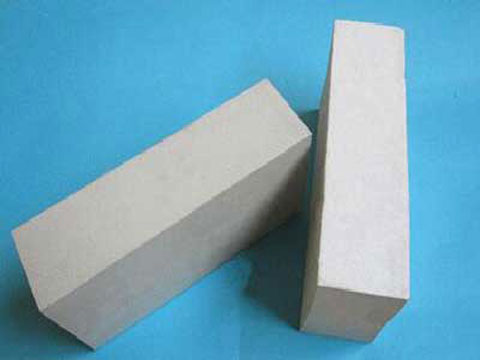
Precautions for Storage and Use of Phosphate-Bonded High Alumina Bricks
Phosphate bricks need to be moisture-proof, both in terms of physical properties and chemical reactions. As for refractory bricks, they all have a common characteristic which is water absorption. Under normal circumstances, it absorbs a small amount of water, and it is not easy to dry naturally. Although it is not afraid of water, it must be dried before use, which delays the progress of the project and wastes time and labor.
Phosphate ions undergo a hydrolysis reaction when exposed to water. Since the reaction is reversible, the price of orthophosphoric acid in phosphate conversion may decrease, and its relative acidity will decrease, which will affect its use characteristics. Therefore, the storage of phosphate bricks needs to be waterproof and moisture-proof.
Buy Fire Bricks Online
Rongsheng refractory brick manufacturer is a refractory brick manufacturer with rich experience in production and sales. We can provide refractory brick for sale, phosphate-bonded aluminum brick. Among many refractories bricks manufacturers, as one of the furnace bricks supplier, our refractory brick products are of reliable quality, and our customer service is comprehensive and thoughtful. Moreover, our technical team can provide configuration schemes of refractory lining materials, as well as construction technical support. Contact us for free quotes and samples.

